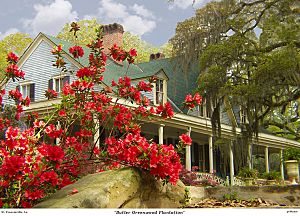Butler Greenwood Plantation facts for kids
Quick facts for kids |
|
|
Butler--Greenwood Plantation
|
|

Butler--Greenwood Plantation
|
|
| Nearest city | St. Francisville, Louisiana |
|---|---|
| Area | 44 acres (18 ha) |
| Built | 1810 |
| NRHP reference No. | 79001103 |
| Added to NRHP | April 17, 1979 |
The Butler Greenwood Plantation is a historic estate in Louisiana. It's located near St. Francisville, Louisiana, right off U.S. Route 61. This special place is recognized on the National Register of Historic Places, which means it's important to American history.
History of Butler Greenwood Plantation
The plantation was started by Dr. Samuel Flower. He was a doctor and a Quaker, which is a type of Christian group. Dr. Flower moved from Pennsylvania in the 1770s. At that time, this area was controlled by the British. Later, when Spain took over, he even treated the Spanish Governor, Manuel Gayoso.
When Dr. Flower passed away in 1813, Louisiana had just become a state. His eight children shared his land. They owned thousands of acres in different parts of Louisiana and even in the Mississippi Territory. The family home, which was valued at $12,300, went to his 20-year-old daughter, Harriett.
Harriett Flower was married to Judge George Mathews. He was an important judge, first in the Mississippi Territory and then in the Territory of Orleans. President Thomas Jefferson himself appointed him. After Louisiana became a state, Judge Mathews became the main judge of the Louisiana Supreme Court. His father, General George Mathews, was a hero from the American Revolutionary War. He was also a US Congressman and a two-time Governor of Georgia.
Harriett and Judge George Mathews lived at Butler Greenwood. They grew crops like indigo, cotton, sugarcane, and corn. They even had their own dock on Bayou Sara to ship their crops. They also owned another large sugar plantation. By the 1850s, they were among the top sugar producers in Louisiana.
After Judge Mathews died in 1836, Harriett continued to manage the plantations. Her son, Charles Lewis Mathews, helped her. In 1860, both Harriett and Charles were listed as "planters." Their household included Charles's wife, Penelope Stewart, their children, a music teacher, and a gardener. At that time, about 96 enslaved people lived and worked on the plantation.
In 1860, the Butler Greenwood Plantation was about 1,400 acres (5.7 km2) big. It produced a lot of crops, including 130 bales of cotton and over 10,000 gallons of molasses. Their other plantations were even larger, covering nearly 10,000 acres (40 km2). After the American Civil War, the number of workers changed. Only 27 freedmen (formerly enslaved people who were now free) worked on the home place for wages.
Butler Greenwood Plantation Today
Today, Butler Greenwood is still owned by the same family. It's home to Anne Butler and her daughter, Chase Poindexter. The house is a simple, raised cottage-style plantation house. It's filled with old family treasures. You can see oil portraits, fancy carpets, and beautiful furniture. There's even a French grand piano! The house also has a special Victorian formal parlor with its original furniture.
Outside, the house is surrounded by lovely gardens and many large live oak trees. The original brick kitchen was built in the 1790s. There's also a garden gazebo from the 1850s.
You can visit Butler Greenwood Plantation! They offer house tours. You can even stay overnight in their bed and breakfast cottages on the plantation grounds. It's a great way to experience history.




